University Nursing Assignment: Evidence-Based Diabetes Care Approach
VerifiedAdded on 2022/10/17
|10
|2337
|67
Report
AI Summary
This report delves into the application of evidence-based practice (EBP) in nursing, specifically addressing diabetes care. The assignment follows the five key steps of EBP: asking a question, gathering information, critically appraising the evidence, implementing the findings in practice, and evaluating the outcomes. The report highlights the significance of diabetes as a prevalent disease, especially among certain ethnic groups, and emphasizes the need for proactive nursing interventions. It explores various aspects of diabetes management, including early diagnosis, therapeutic interventions, dietary considerations, and the role of nurses in patient education and support. The report also discusses the critical appraisal of relevant literature, implementation strategies such as encouraging physical activity, proper diet charts, and wound management, and the evaluation of the overall approach through monitoring patient progress and adhering to nursing codes of conduct. The conclusion underscores the importance of EBP in improving diabetes care, the nurse's role in providing expert opinions, and the need for continuous self-improvement to provide better patient care. The report also includes references to support the information provided.
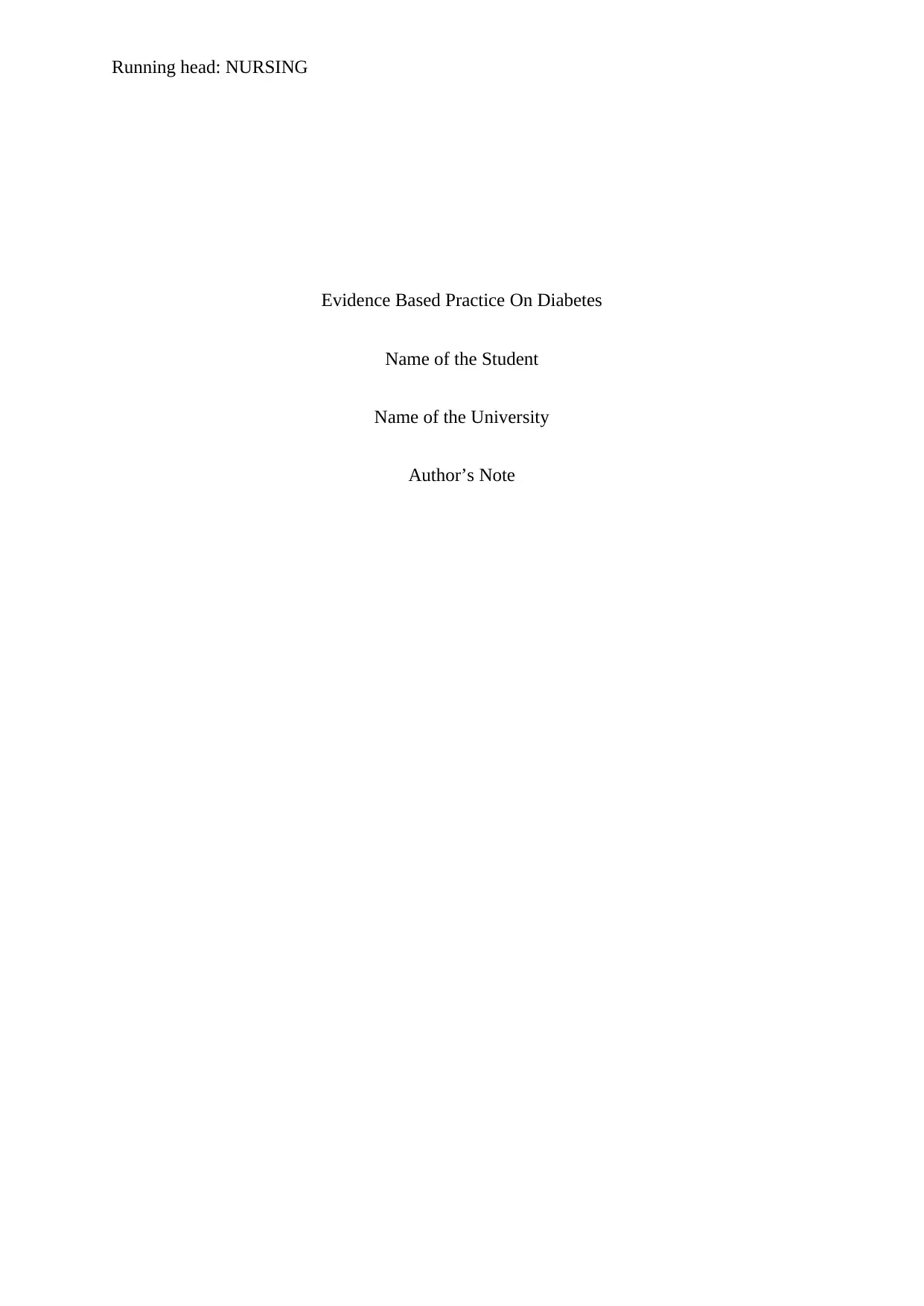
Running head: NURSING
Evidence Based Practice On Diabetes
Name of the Student
Name of the University
Author’s Note
Evidence Based Practice On Diabetes
Name of the Student
Name of the University
Author’s Note
Paraphrase This Document
Need a fresh take? Get an instant paraphrase of this document with our AI Paraphraser
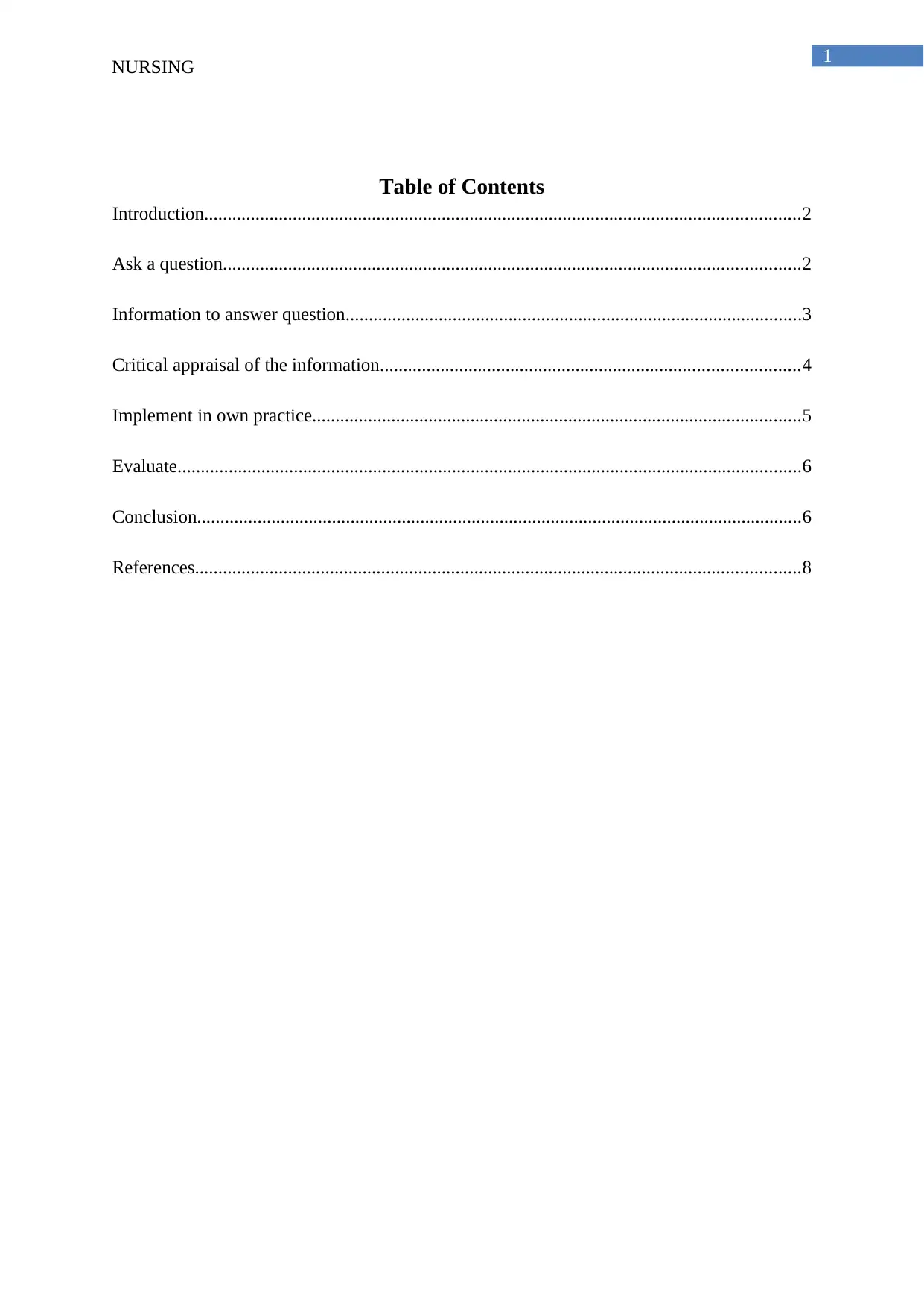
1
NURSING
Table of Contents
Introduction................................................................................................................................2
Ask a question............................................................................................................................2
Information to answer question..................................................................................................3
Critical appraisal of the information..........................................................................................4
Implement in own practice.........................................................................................................5
Evaluate......................................................................................................................................6
Conclusion..................................................................................................................................6
References..................................................................................................................................8
NURSING
Table of Contents
Introduction................................................................................................................................2
Ask a question............................................................................................................................2
Information to answer question..................................................................................................3
Critical appraisal of the information..........................................................................................4
Implement in own practice.........................................................................................................5
Evaluate......................................................................................................................................6
Conclusion..................................................................................................................................6
References..................................................................................................................................8
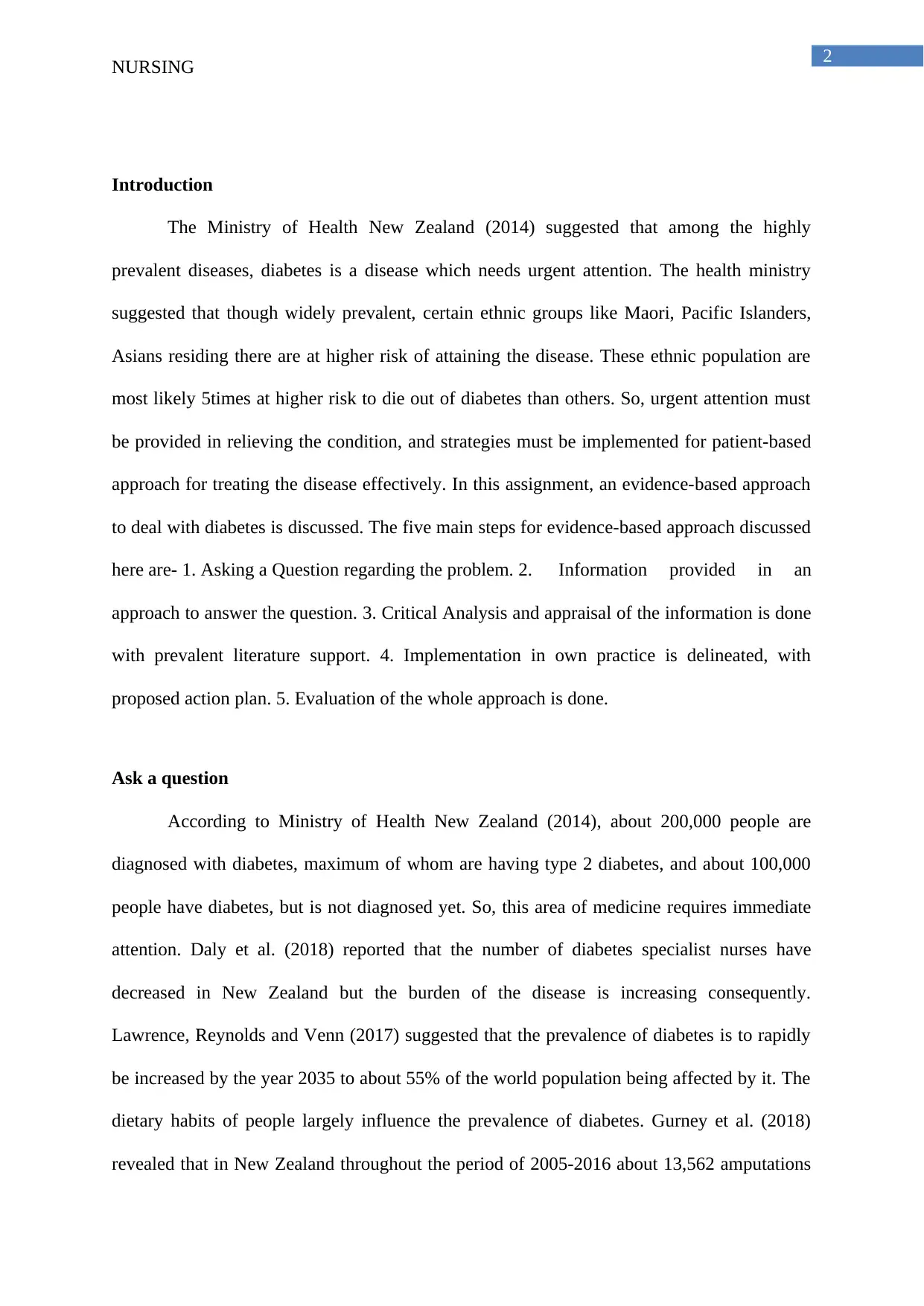
2
NURSING
Introduction
The Ministry of Health New Zealand (2014) suggested that among the highly
prevalent diseases, diabetes is a disease which needs urgent attention. The health ministry
suggested that though widely prevalent, certain ethnic groups like Maori, Pacific Islanders,
Asians residing there are at higher risk of attaining the disease. These ethnic population are
most likely 5times at higher risk to die out of diabetes than others. So, urgent attention must
be provided in relieving the condition, and strategies must be implemented for patient-based
approach for treating the disease effectively. In this assignment, an evidence-based approach
to deal with diabetes is discussed. The five main steps for evidence-based approach discussed
here are- 1. Asking a Question regarding the problem. 2. Information provided in an
approach to answer the question. 3. Critical Analysis and appraisal of the information is done
with prevalent literature support. 4. Implementation in own practice is delineated, with
proposed action plan. 5. Evaluation of the whole approach is done.
Ask a question
According to Ministry of Health New Zealand (2014), about 200,000 people are
diagnosed with diabetes, maximum of whom are having type 2 diabetes, and about 100,000
people have diabetes, but is not diagnosed yet. So, this area of medicine requires immediate
attention. Daly et al. (2018) reported that the number of diabetes specialist nurses have
decreased in New Zealand but the burden of the disease is increasing consequently.
Lawrence, Reynolds and Venn (2017) suggested that the prevalence of diabetes is to rapidly
be increased by the year 2035 to about 55% of the world population being affected by it. The
dietary habits of people largely influence the prevalence of diabetes. Gurney et al. (2018)
revealed that in New Zealand throughout the period of 2005-2016 about 13,562 amputations
NURSING
Introduction
The Ministry of Health New Zealand (2014) suggested that among the highly
prevalent diseases, diabetes is a disease which needs urgent attention. The health ministry
suggested that though widely prevalent, certain ethnic groups like Maori, Pacific Islanders,
Asians residing there are at higher risk of attaining the disease. These ethnic population are
most likely 5times at higher risk to die out of diabetes than others. So, urgent attention must
be provided in relieving the condition, and strategies must be implemented for patient-based
approach for treating the disease effectively. In this assignment, an evidence-based approach
to deal with diabetes is discussed. The five main steps for evidence-based approach discussed
here are- 1. Asking a Question regarding the problem. 2. Information provided in an
approach to answer the question. 3. Critical Analysis and appraisal of the information is done
with prevalent literature support. 4. Implementation in own practice is delineated, with
proposed action plan. 5. Evaluation of the whole approach is done.
Ask a question
According to Ministry of Health New Zealand (2014), about 200,000 people are
diagnosed with diabetes, maximum of whom are having type 2 diabetes, and about 100,000
people have diabetes, but is not diagnosed yet. So, this area of medicine requires immediate
attention. Daly et al. (2018) reported that the number of diabetes specialist nurses have
decreased in New Zealand but the burden of the disease is increasing consequently.
Lawrence, Reynolds and Venn (2017) suggested that the prevalence of diabetes is to rapidly
be increased by the year 2035 to about 55% of the world population being affected by it. The
dietary habits of people largely influence the prevalence of diabetes. Gurney et al. (2018)
revealed that in New Zealand throughout the period of 2005-2016 about 13,562 amputations
⊘ This is a preview!⊘
Do you want full access?
Subscribe today to unlock all pages.

Trusted by 1+ million students worldwide
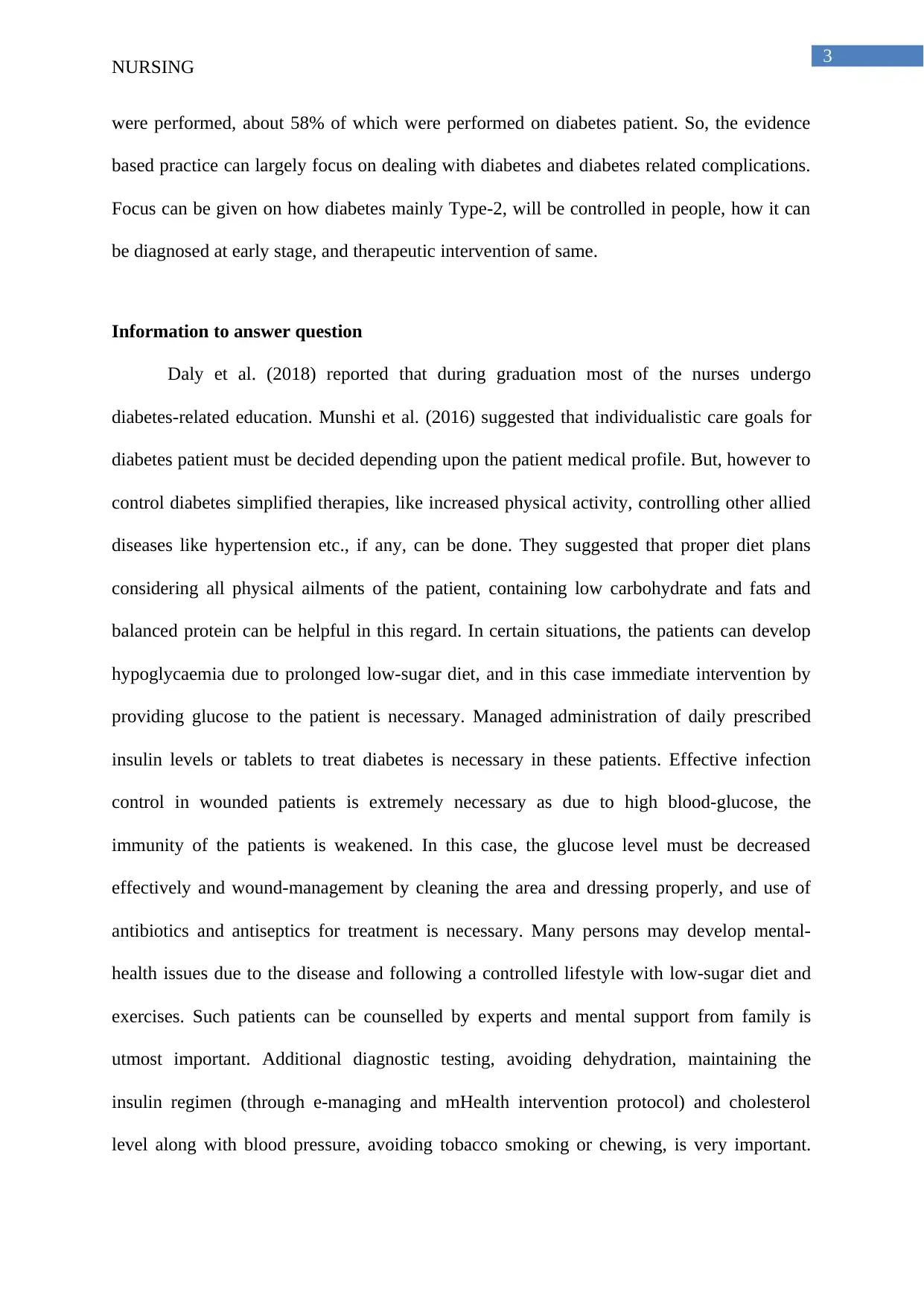
3
NURSING
were performed, about 58% of which were performed on diabetes patient. So, the evidence
based practice can largely focus on dealing with diabetes and diabetes related complications.
Focus can be given on how diabetes mainly Type-2, will be controlled in people, how it can
be diagnosed at early stage, and therapeutic intervention of same.
Information to answer question
Daly et al. (2018) reported that during graduation most of the nurses undergo
diabetes-related education. Munshi et al. (2016) suggested that individualistic care goals for
diabetes patient must be decided depending upon the patient medical profile. But, however to
control diabetes simplified therapies, like increased physical activity, controlling other allied
diseases like hypertension etc., if any, can be done. They suggested that proper diet plans
considering all physical ailments of the patient, containing low carbohydrate and fats and
balanced protein can be helpful in this regard. In certain situations, the patients can develop
hypoglycaemia due to prolonged low-sugar diet, and in this case immediate intervention by
providing glucose to the patient is necessary. Managed administration of daily prescribed
insulin levels or tablets to treat diabetes is necessary in these patients. Effective infection
control in wounded patients is extremely necessary as due to high blood-glucose, the
immunity of the patients is weakened. In this case, the glucose level must be decreased
effectively and wound-management by cleaning the area and dressing properly, and use of
antibiotics and antiseptics for treatment is necessary. Many persons may develop mental-
health issues due to the disease and following a controlled lifestyle with low-sugar diet and
exercises. Such patients can be counselled by experts and mental support from family is
utmost important. Additional diagnostic testing, avoiding dehydration, maintaining the
insulin regimen (through e-managing and mHealth intervention protocol) and cholesterol
level along with blood pressure, avoiding tobacco smoking or chewing, is very important.
NURSING
were performed, about 58% of which were performed on diabetes patient. So, the evidence
based practice can largely focus on dealing with diabetes and diabetes related complications.
Focus can be given on how diabetes mainly Type-2, will be controlled in people, how it can
be diagnosed at early stage, and therapeutic intervention of same.
Information to answer question
Daly et al. (2018) reported that during graduation most of the nurses undergo
diabetes-related education. Munshi et al. (2016) suggested that individualistic care goals for
diabetes patient must be decided depending upon the patient medical profile. But, however to
control diabetes simplified therapies, like increased physical activity, controlling other allied
diseases like hypertension etc., if any, can be done. They suggested that proper diet plans
considering all physical ailments of the patient, containing low carbohydrate and fats and
balanced protein can be helpful in this regard. In certain situations, the patients can develop
hypoglycaemia due to prolonged low-sugar diet, and in this case immediate intervention by
providing glucose to the patient is necessary. Managed administration of daily prescribed
insulin levels or tablets to treat diabetes is necessary in these patients. Effective infection
control in wounded patients is extremely necessary as due to high blood-glucose, the
immunity of the patients is weakened. In this case, the glucose level must be decreased
effectively and wound-management by cleaning the area and dressing properly, and use of
antibiotics and antiseptics for treatment is necessary. Many persons may develop mental-
health issues due to the disease and following a controlled lifestyle with low-sugar diet and
exercises. Such patients can be counselled by experts and mental support from family is
utmost important. Additional diagnostic testing, avoiding dehydration, maintaining the
insulin regimen (through e-managing and mHealth intervention protocol) and cholesterol
level along with blood pressure, avoiding tobacco smoking or chewing, is very important.
Paraphrase This Document
Need a fresh take? Get an instant paraphrase of this document with our AI Paraphraser
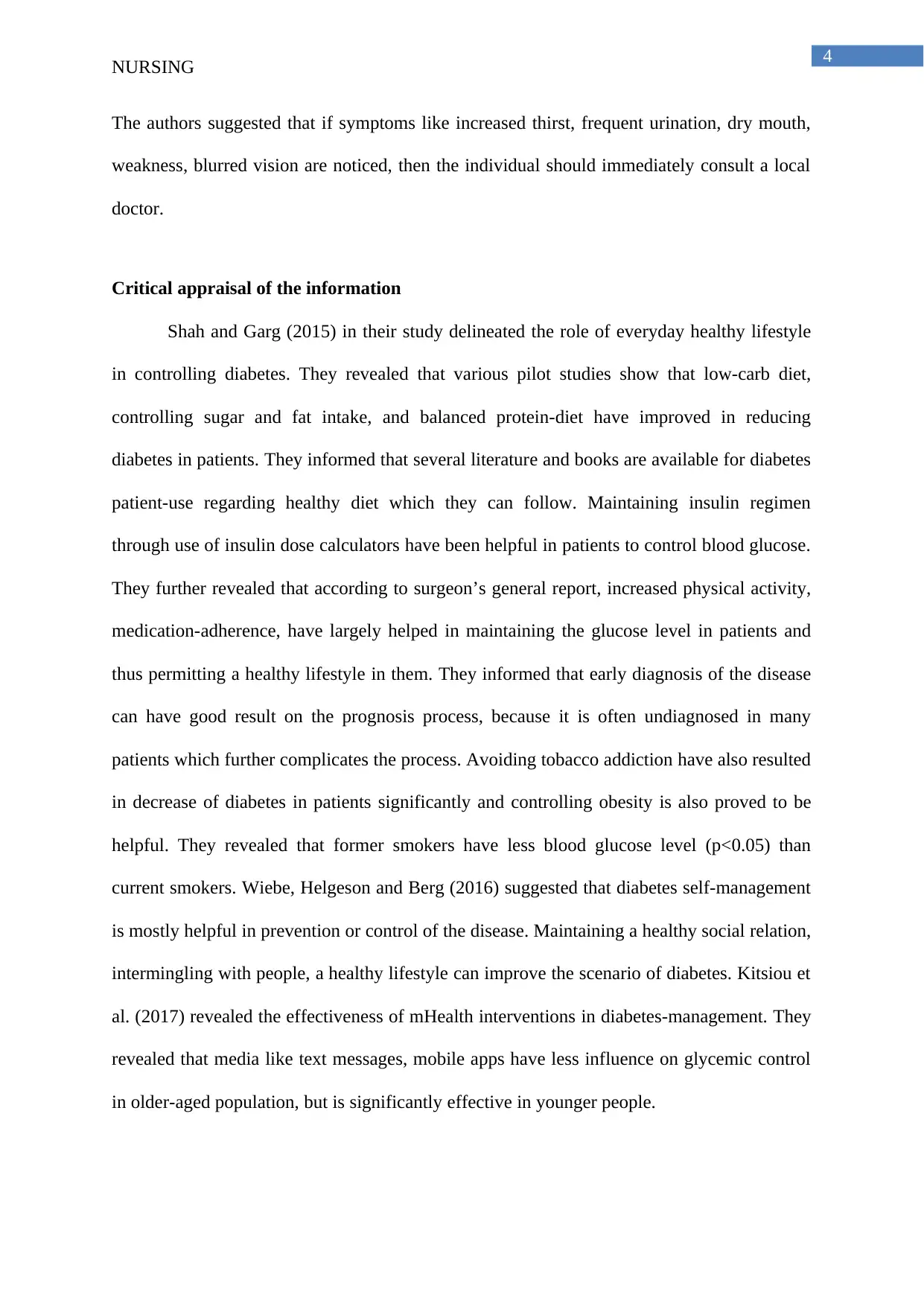
4
NURSING
The authors suggested that if symptoms like increased thirst, frequent urination, dry mouth,
weakness, blurred vision are noticed, then the individual should immediately consult a local
doctor.
Critical appraisal of the information
Shah and Garg (2015) in their study delineated the role of everyday healthy lifestyle
in controlling diabetes. They revealed that various pilot studies show that low-carb diet,
controlling sugar and fat intake, and balanced protein-diet have improved in reducing
diabetes in patients. They informed that several literature and books are available for diabetes
patient-use regarding healthy diet which they can follow. Maintaining insulin regimen
through use of insulin dose calculators have been helpful in patients to control blood glucose.
They further revealed that according to surgeon’s general report, increased physical activity,
medication-adherence, have largely helped in maintaining the glucose level in patients and
thus permitting a healthy lifestyle in them. They informed that early diagnosis of the disease
can have good result on the prognosis process, because it is often undiagnosed in many
patients which further complicates the process. Avoiding tobacco addiction have also resulted
in decrease of diabetes in patients significantly and controlling obesity is also proved to be
helpful. They revealed that former smokers have less blood glucose level (p<0.05) than
current smokers. Wiebe, Helgeson and Berg (2016) suggested that diabetes self-management
is mostly helpful in prevention or control of the disease. Maintaining a healthy social relation,
intermingling with people, a healthy lifestyle can improve the scenario of diabetes. Kitsiou et
al. (2017) revealed the effectiveness of mHealth interventions in diabetes-management. They
revealed that media like text messages, mobile apps have less influence on glycemic control
in older-aged population, but is significantly effective in younger people.
NURSING
The authors suggested that if symptoms like increased thirst, frequent urination, dry mouth,
weakness, blurred vision are noticed, then the individual should immediately consult a local
doctor.
Critical appraisal of the information
Shah and Garg (2015) in their study delineated the role of everyday healthy lifestyle
in controlling diabetes. They revealed that various pilot studies show that low-carb diet,
controlling sugar and fat intake, and balanced protein-diet have improved in reducing
diabetes in patients. They informed that several literature and books are available for diabetes
patient-use regarding healthy diet which they can follow. Maintaining insulin regimen
through use of insulin dose calculators have been helpful in patients to control blood glucose.
They further revealed that according to surgeon’s general report, increased physical activity,
medication-adherence, have largely helped in maintaining the glucose level in patients and
thus permitting a healthy lifestyle in them. They informed that early diagnosis of the disease
can have good result on the prognosis process, because it is often undiagnosed in many
patients which further complicates the process. Avoiding tobacco addiction have also resulted
in decrease of diabetes in patients significantly and controlling obesity is also proved to be
helpful. They revealed that former smokers have less blood glucose level (p<0.05) than
current smokers. Wiebe, Helgeson and Berg (2016) suggested that diabetes self-management
is mostly helpful in prevention or control of the disease. Maintaining a healthy social relation,
intermingling with people, a healthy lifestyle can improve the scenario of diabetes. Kitsiou et
al. (2017) revealed the effectiveness of mHealth interventions in diabetes-management. They
revealed that media like text messages, mobile apps have less influence on glycemic control
in older-aged population, but is significantly effective in younger people.
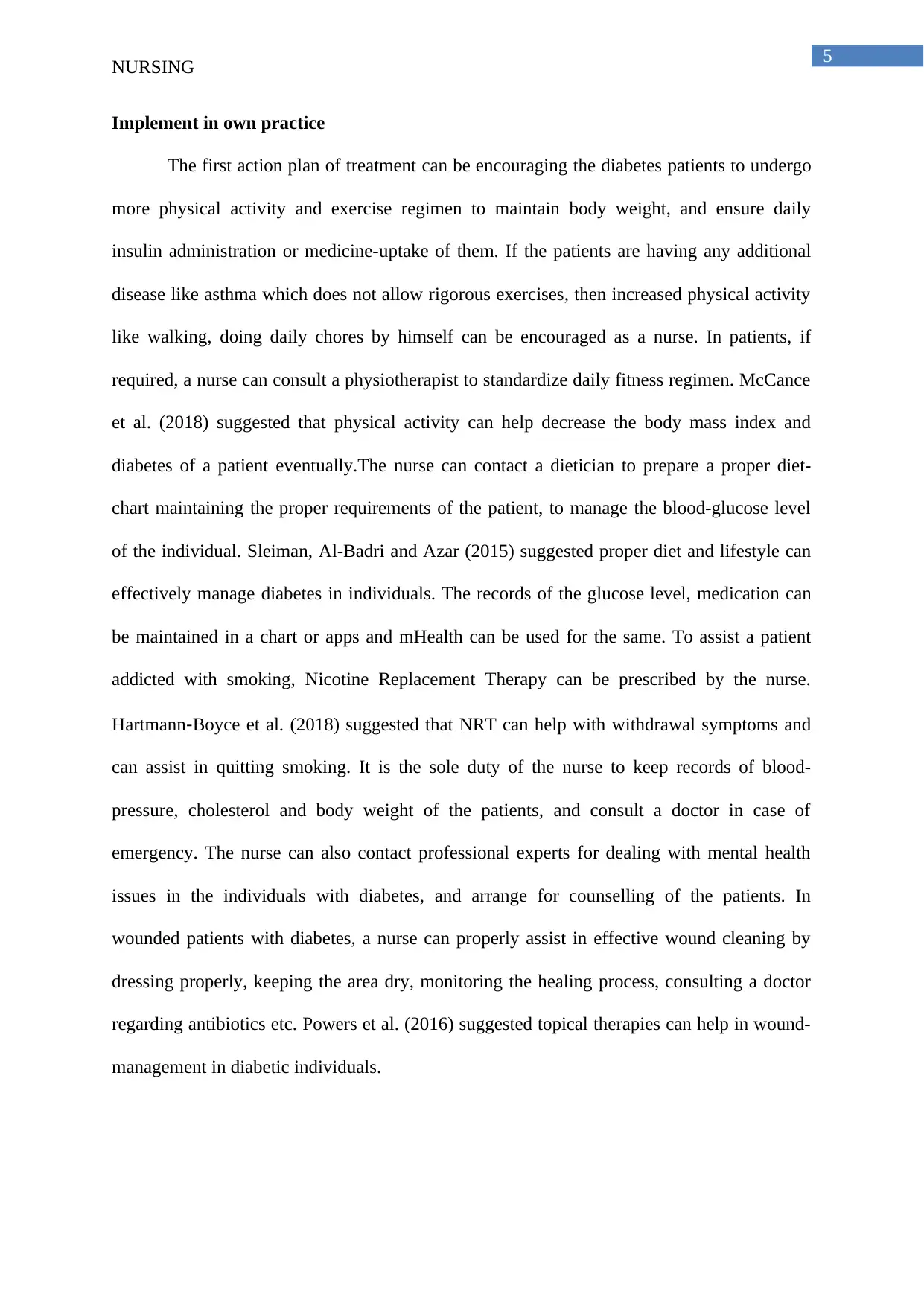
5
NURSING
Implement in own practice
The first action plan of treatment can be encouraging the diabetes patients to undergo
more physical activity and exercise regimen to maintain body weight, and ensure daily
insulin administration or medicine-uptake of them. If the patients are having any additional
disease like asthma which does not allow rigorous exercises, then increased physical activity
like walking, doing daily chores by himself can be encouraged as a nurse. In patients, if
required, a nurse can consult a physiotherapist to standardize daily fitness regimen. McCance
et al. (2018) suggested that physical activity can help decrease the body mass index and
diabetes of a patient eventually.The nurse can contact a dietician to prepare a proper diet-
chart maintaining the proper requirements of the patient, to manage the blood-glucose level
of the individual. Sleiman, Al-Badri and Azar (2015) suggested proper diet and lifestyle can
effectively manage diabetes in individuals. The records of the glucose level, medication can
be maintained in a chart or apps and mHealth can be used for the same. To assist a patient
addicted with smoking, Nicotine Replacement Therapy can be prescribed by the nurse.
Hartmann‐Boyce et al. (2018) suggested that NRT can help with withdrawal symptoms and
can assist in quitting smoking. It is the sole duty of the nurse to keep records of blood-
pressure, cholesterol and body weight of the patients, and consult a doctor in case of
emergency. The nurse can also contact professional experts for dealing with mental health
issues in the individuals with diabetes, and arrange for counselling of the patients. In
wounded patients with diabetes, a nurse can properly assist in effective wound cleaning by
dressing properly, keeping the area dry, monitoring the healing process, consulting a doctor
regarding antibiotics etc. Powers et al. (2016) suggested topical therapies can help in wound-
management in diabetic individuals.
NURSING
Implement in own practice
The first action plan of treatment can be encouraging the diabetes patients to undergo
more physical activity and exercise regimen to maintain body weight, and ensure daily
insulin administration or medicine-uptake of them. If the patients are having any additional
disease like asthma which does not allow rigorous exercises, then increased physical activity
like walking, doing daily chores by himself can be encouraged as a nurse. In patients, if
required, a nurse can consult a physiotherapist to standardize daily fitness regimen. McCance
et al. (2018) suggested that physical activity can help decrease the body mass index and
diabetes of a patient eventually.The nurse can contact a dietician to prepare a proper diet-
chart maintaining the proper requirements of the patient, to manage the blood-glucose level
of the individual. Sleiman, Al-Badri and Azar (2015) suggested proper diet and lifestyle can
effectively manage diabetes in individuals. The records of the glucose level, medication can
be maintained in a chart or apps and mHealth can be used for the same. To assist a patient
addicted with smoking, Nicotine Replacement Therapy can be prescribed by the nurse.
Hartmann‐Boyce et al. (2018) suggested that NRT can help with withdrawal symptoms and
can assist in quitting smoking. It is the sole duty of the nurse to keep records of blood-
pressure, cholesterol and body weight of the patients, and consult a doctor in case of
emergency. The nurse can also contact professional experts for dealing with mental health
issues in the individuals with diabetes, and arrange for counselling of the patients. In
wounded patients with diabetes, a nurse can properly assist in effective wound cleaning by
dressing properly, keeping the area dry, monitoring the healing process, consulting a doctor
regarding antibiotics etc. Powers et al. (2016) suggested topical therapies can help in wound-
management in diabetic individuals.
⊘ This is a preview!⊘
Do you want full access?
Subscribe today to unlock all pages.

Trusted by 1+ million students worldwide
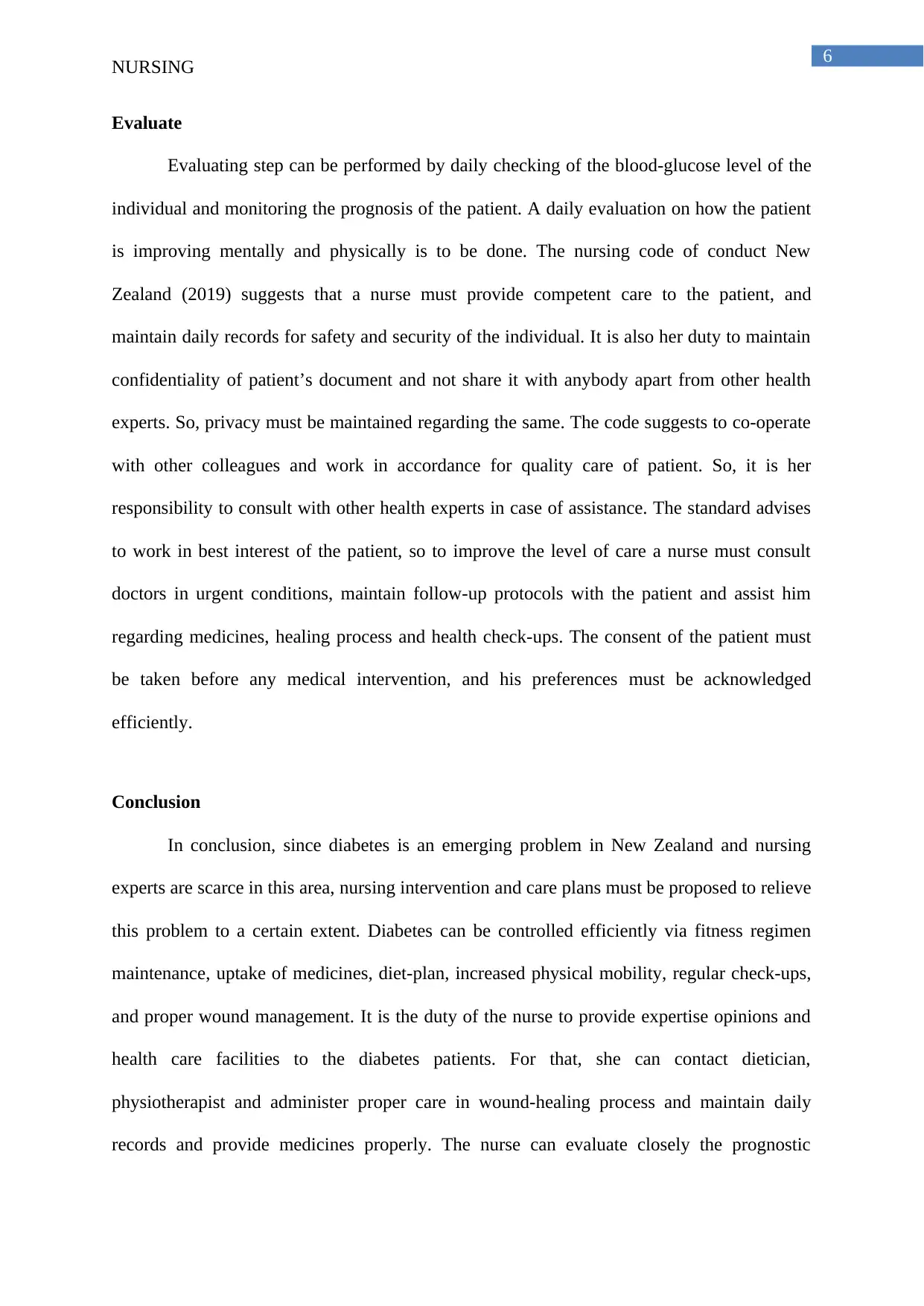
6
NURSING
Evaluate
Evaluating step can be performed by daily checking of the blood-glucose level of the
individual and monitoring the prognosis of the patient. A daily evaluation on how the patient
is improving mentally and physically is to be done. The nursing code of conduct New
Zealand (2019) suggests that a nurse must provide competent care to the patient, and
maintain daily records for safety and security of the individual. It is also her duty to maintain
confidentiality of patient’s document and not share it with anybody apart from other health
experts. So, privacy must be maintained regarding the same. The code suggests to co-operate
with other colleagues and work in accordance for quality care of patient. So, it is her
responsibility to consult with other health experts in case of assistance. The standard advises
to work in best interest of the patient, so to improve the level of care a nurse must consult
doctors in urgent conditions, maintain follow-up protocols with the patient and assist him
regarding medicines, healing process and health check-ups. The consent of the patient must
be taken before any medical intervention, and his preferences must be acknowledged
efficiently.
Conclusion
In conclusion, since diabetes is an emerging problem in New Zealand and nursing
experts are scarce in this area, nursing intervention and care plans must be proposed to relieve
this problem to a certain extent. Diabetes can be controlled efficiently via fitness regimen
maintenance, uptake of medicines, diet-plan, increased physical mobility, regular check-ups,
and proper wound management. It is the duty of the nurse to provide expertise opinions and
health care facilities to the diabetes patients. For that, she can contact dietician,
physiotherapist and administer proper care in wound-healing process and maintain daily
records and provide medicines properly. The nurse can evaluate closely the prognostic
NURSING
Evaluate
Evaluating step can be performed by daily checking of the blood-glucose level of the
individual and monitoring the prognosis of the patient. A daily evaluation on how the patient
is improving mentally and physically is to be done. The nursing code of conduct New
Zealand (2019) suggests that a nurse must provide competent care to the patient, and
maintain daily records for safety and security of the individual. It is also her duty to maintain
confidentiality of patient’s document and not share it with anybody apart from other health
experts. So, privacy must be maintained regarding the same. The code suggests to co-operate
with other colleagues and work in accordance for quality care of patient. So, it is her
responsibility to consult with other health experts in case of assistance. The standard advises
to work in best interest of the patient, so to improve the level of care a nurse must consult
doctors in urgent conditions, maintain follow-up protocols with the patient and assist him
regarding medicines, healing process and health check-ups. The consent of the patient must
be taken before any medical intervention, and his preferences must be acknowledged
efficiently.
Conclusion
In conclusion, since diabetes is an emerging problem in New Zealand and nursing
experts are scarce in this area, nursing intervention and care plans must be proposed to relieve
this problem to a certain extent. Diabetes can be controlled efficiently via fitness regimen
maintenance, uptake of medicines, diet-plan, increased physical mobility, regular check-ups,
and proper wound management. It is the duty of the nurse to provide expertise opinions and
health care facilities to the diabetes patients. For that, she can contact dietician,
physiotherapist and administer proper care in wound-healing process and maintain daily
records and provide medicines properly. The nurse can evaluate closely the prognostic
Paraphrase This Document
Need a fresh take? Get an instant paraphrase of this document with our AI Paraphraser
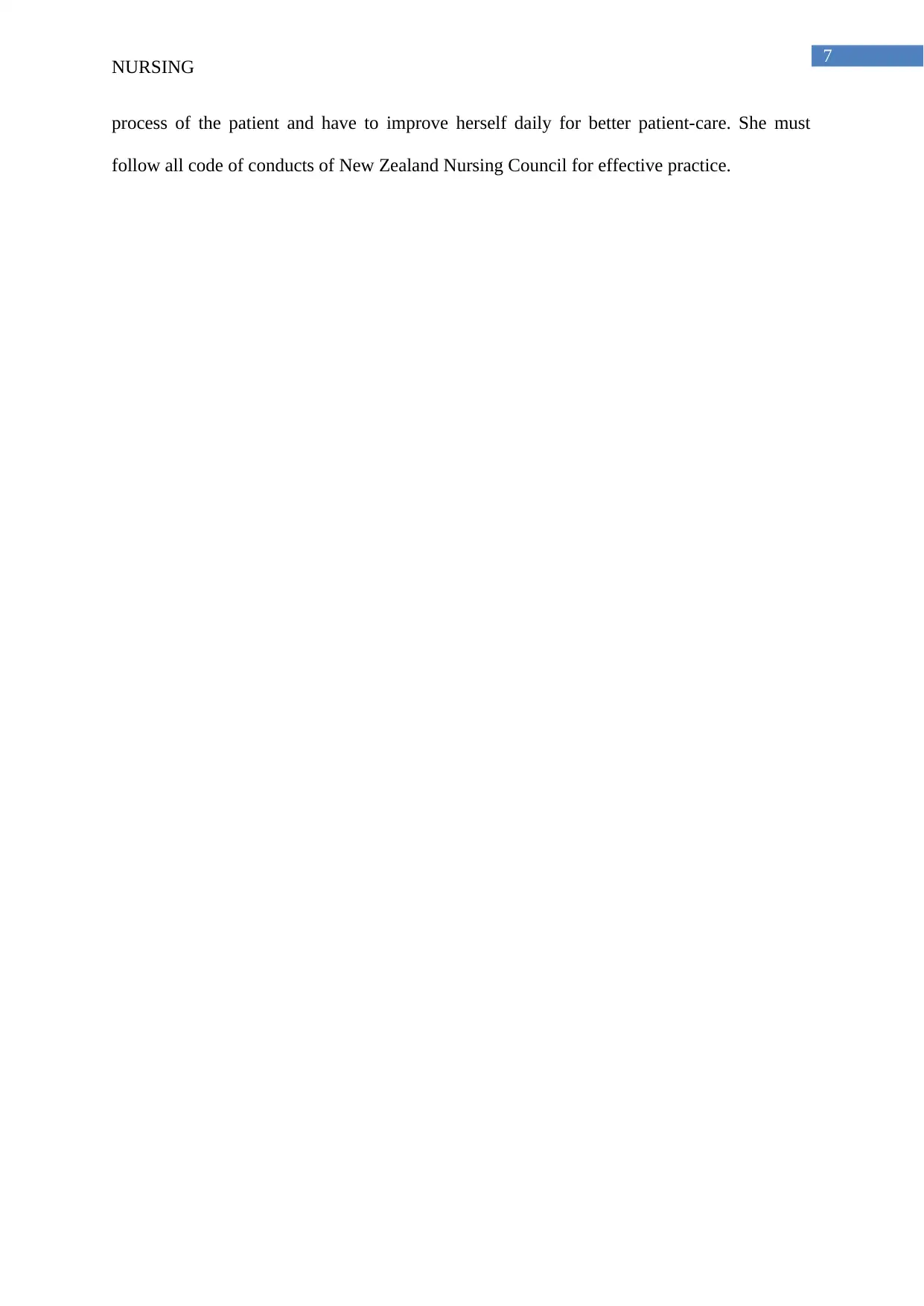
7
NURSING
process of the patient and have to improve herself daily for better patient-care. She must
follow all code of conducts of New Zealand Nursing Council for effective practice.
NURSING
process of the patient and have to improve herself daily for better patient-care. She must
follow all code of conducts of New Zealand Nursing Council for effective practice.
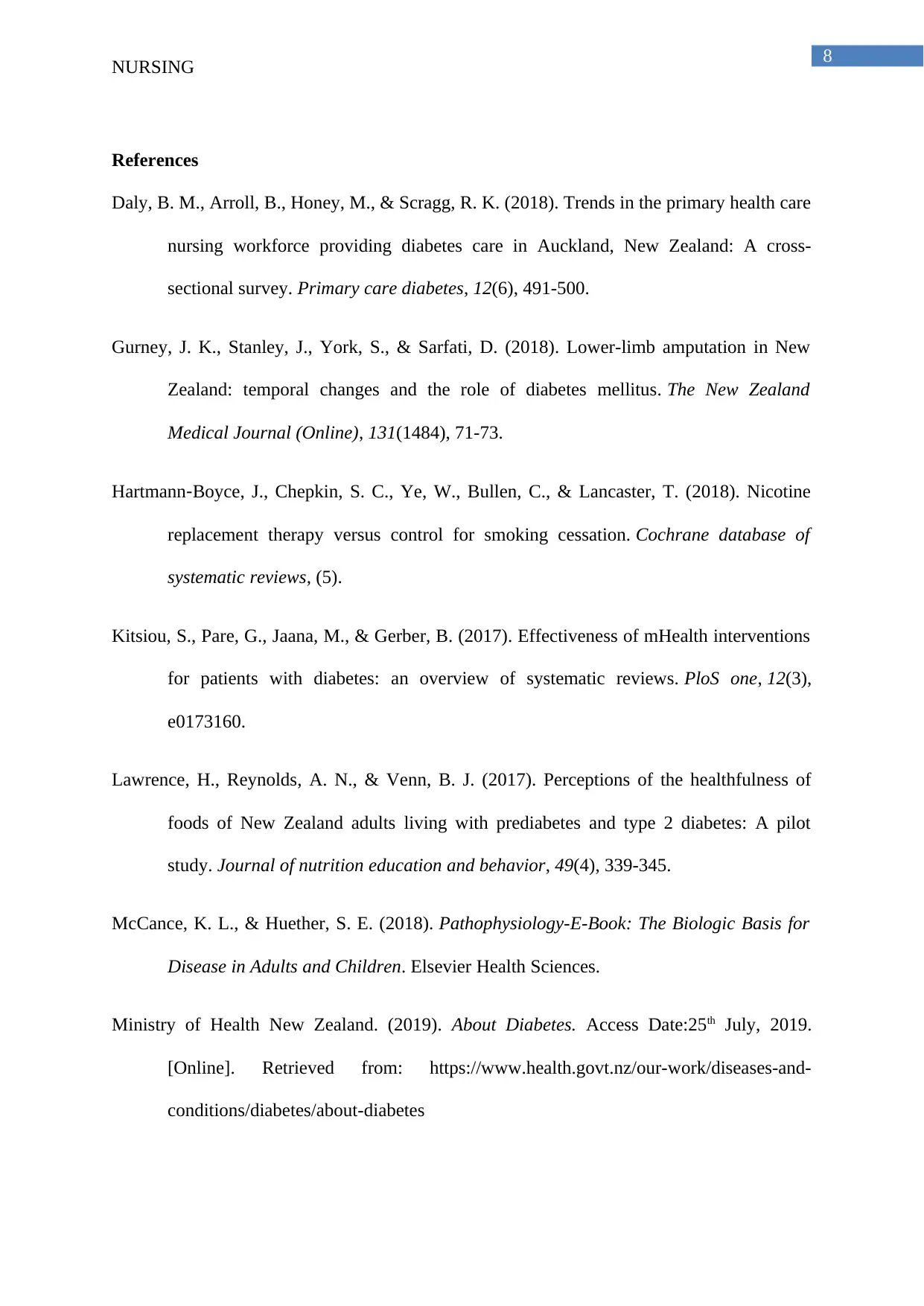
8
NURSING
References
Daly, B. M., Arroll, B., Honey, M., & Scragg, R. K. (2018). Trends in the primary health care
nursing workforce providing diabetes care in Auckland, New Zealand: A cross-
sectional survey. Primary care diabetes, 12(6), 491-500.
Gurney, J. K., Stanley, J., York, S., & Sarfati, D. (2018). Lower-limb amputation in New
Zealand: temporal changes and the role of diabetes mellitus. The New Zealand
Medical Journal (Online), 131(1484), 71-73.
Hartmann‐Boyce, J., Chepkin, S. C., Ye, W., Bullen, C., & Lancaster, T. (2018). Nicotine
replacement therapy versus control for smoking cessation. Cochrane database of
systematic reviews, (5).
Kitsiou, S., Pare, G., Jaana, M., & Gerber, B. (2017). Effectiveness of mHealth interventions
for patients with diabetes: an overview of systematic reviews. PloS one, 12(3),
e0173160.
Lawrence, H., Reynolds, A. N., & Venn, B. J. (2017). Perceptions of the healthfulness of
foods of New Zealand adults living with prediabetes and type 2 diabetes: A pilot
study. Journal of nutrition education and behavior, 49(4), 339-345.
McCance, K. L., & Huether, S. E. (2018). Pathophysiology-E-Book: The Biologic Basis for
Disease in Adults and Children. Elsevier Health Sciences.
Ministry of Health New Zealand. (2019). About Diabetes. Access Date:25th July, 2019.
[Online]. Retrieved from: https://www.health.govt.nz/our-work/diseases-and-
conditions/diabetes/about-diabetes
NURSING
References
Daly, B. M., Arroll, B., Honey, M., & Scragg, R. K. (2018). Trends in the primary health care
nursing workforce providing diabetes care in Auckland, New Zealand: A cross-
sectional survey. Primary care diabetes, 12(6), 491-500.
Gurney, J. K., Stanley, J., York, S., & Sarfati, D. (2018). Lower-limb amputation in New
Zealand: temporal changes and the role of diabetes mellitus. The New Zealand
Medical Journal (Online), 131(1484), 71-73.
Hartmann‐Boyce, J., Chepkin, S. C., Ye, W., Bullen, C., & Lancaster, T. (2018). Nicotine
replacement therapy versus control for smoking cessation. Cochrane database of
systematic reviews, (5).
Kitsiou, S., Pare, G., Jaana, M., & Gerber, B. (2017). Effectiveness of mHealth interventions
for patients with diabetes: an overview of systematic reviews. PloS one, 12(3),
e0173160.
Lawrence, H., Reynolds, A. N., & Venn, B. J. (2017). Perceptions of the healthfulness of
foods of New Zealand adults living with prediabetes and type 2 diabetes: A pilot
study. Journal of nutrition education and behavior, 49(4), 339-345.
McCance, K. L., & Huether, S. E. (2018). Pathophysiology-E-Book: The Biologic Basis for
Disease in Adults and Children. Elsevier Health Sciences.
Ministry of Health New Zealand. (2019). About Diabetes. Access Date:25th July, 2019.
[Online]. Retrieved from: https://www.health.govt.nz/our-work/diseases-and-
conditions/diabetes/about-diabetes
⊘ This is a preview!⊘
Do you want full access?
Subscribe today to unlock all pages.

Trusted by 1+ million students worldwide
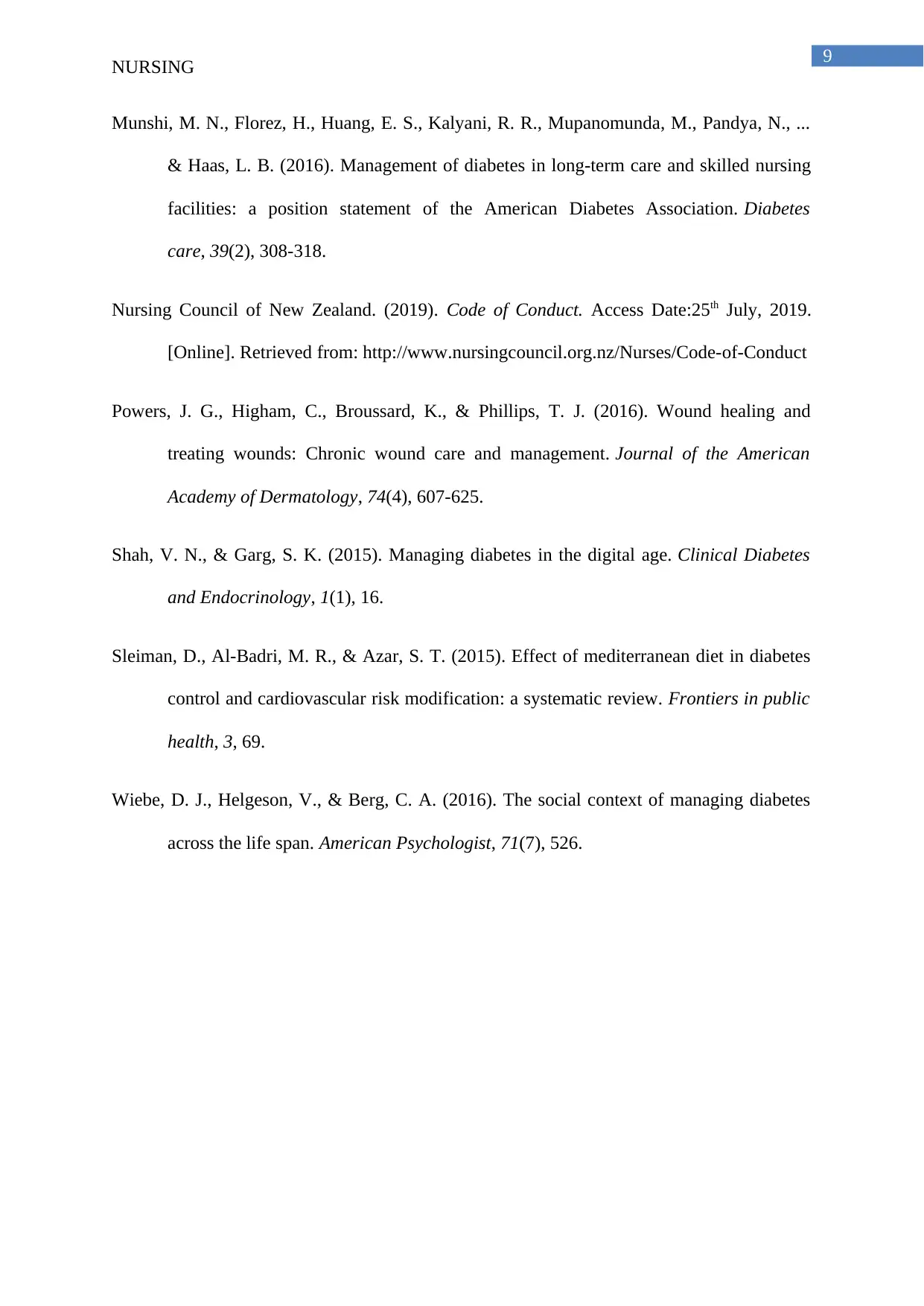
9
NURSING
Munshi, M. N., Florez, H., Huang, E. S., Kalyani, R. R., Mupanomunda, M., Pandya, N., ...
& Haas, L. B. (2016). Management of diabetes in long-term care and skilled nursing
facilities: a position statement of the American Diabetes Association. Diabetes
care, 39(2), 308-318.
Nursing Council of New Zealand. (2019). Code of Conduct. Access Date:25th July, 2019.
[Online]. Retrieved from: http://www.nursingcouncil.org.nz/Nurses/Code-of-Conduct
Powers, J. G., Higham, C., Broussard, K., & Phillips, T. J. (2016). Wound healing and
treating wounds: Chronic wound care and management. Journal of the American
Academy of Dermatology, 74(4), 607-625.
Shah, V. N., & Garg, S. K. (2015). Managing diabetes in the digital age. Clinical Diabetes
and Endocrinology, 1(1), 16.
Sleiman, D., Al-Badri, M. R., & Azar, S. T. (2015). Effect of mediterranean diet in diabetes
control and cardiovascular risk modification: a systematic review. Frontiers in public
health, 3, 69.
Wiebe, D. J., Helgeson, V., & Berg, C. A. (2016). The social context of managing diabetes
across the life span. American Psychologist, 71(7), 526.
NURSING
Munshi, M. N., Florez, H., Huang, E. S., Kalyani, R. R., Mupanomunda, M., Pandya, N., ...
& Haas, L. B. (2016). Management of diabetes in long-term care and skilled nursing
facilities: a position statement of the American Diabetes Association. Diabetes
care, 39(2), 308-318.
Nursing Council of New Zealand. (2019). Code of Conduct. Access Date:25th July, 2019.
[Online]. Retrieved from: http://www.nursingcouncil.org.nz/Nurses/Code-of-Conduct
Powers, J. G., Higham, C., Broussard, K., & Phillips, T. J. (2016). Wound healing and
treating wounds: Chronic wound care and management. Journal of the American
Academy of Dermatology, 74(4), 607-625.
Shah, V. N., & Garg, S. K. (2015). Managing diabetes in the digital age. Clinical Diabetes
and Endocrinology, 1(1), 16.
Sleiman, D., Al-Badri, M. R., & Azar, S. T. (2015). Effect of mediterranean diet in diabetes
control and cardiovascular risk modification: a systematic review. Frontiers in public
health, 3, 69.
Wiebe, D. J., Helgeson, V., & Berg, C. A. (2016). The social context of managing diabetes
across the life span. American Psychologist, 71(7), 526.
1 out of 10
Related Documents
Your All-in-One AI-Powered Toolkit for Academic Success.
+13062052269
info@desklib.com
Available 24*7 on WhatsApp / Email
![[object Object]](/_next/static/media/star-bottom.7253800d.svg)
Unlock your academic potential
Copyright © 2020–2025 A2Z Services. All Rights Reserved. Developed and managed by ZUCOL.





